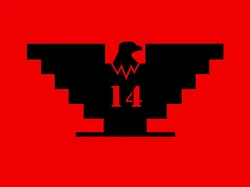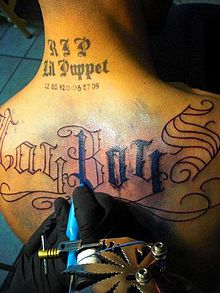
Norteños are the various, affiliated gangs that pay tribute to Nuestra Familia while in California state and federal correctional facilities. Norteños may refer to Northern California as Norte Califas. Their biggest rivals are the Sureños from Southern California. As of 2008, the statewide north–south dividing line between Norteños and Sureños was regarded as running through the southern end of the Central Valley. The gang's membership consists primarily of Mexican Americans.

The 18th Street Gang, also known as Calle 18, Barrio 18, Mara 18, or simply 18 in North America, is a multi-ethnic transnational criminal organization that started as a street gang in Los Angeles. It is one of the largest transnational criminal gangs in Los Angeles, with 30,000-50,000 members between the United States, Mexico, and Central America and is also allied with the Mexican Mafia, another US-based crime organization. A United States Department of Justice report featured the following statement regarding 18th Street and rival gang MS-13, "These two gangs have turned the Central American northern triangle into the area with the highest homicide rate in the world."

The Mexican Mafia, also known as La eMe, is a Mexican American criminal organization in the United States. Despite its name, the Mexican Mafia has no origins in Mexico, and is entirely a U.S. criminal prison organization. Law enforcement officials report that the Mexican Mafia is the deadliest and most powerful gang within the California prison system.
Venice 13 or West Side Venice 13, abbreviated as V13 or VX3, is a Mexican American street gang based in the Oakwood neighborhood of Venice, a section of Los Angeles, California. It has a substantial presence in East Venice as well as the Culver City/Los Angeles border, especially around Washington Blvd.
OVS is a Mexican American (Chicano) gang from Ontario, California.
Varrio Nuevo Estrada, also known as VNEx3, is a Chicano criminal street gang founded in Boyle Heights, California, in the Estrada Courts housing projects. VNE is one of 34 gangs in a 15-square-mile area east of downtown Los Angeles.

The 38th Street Gang is an American criminal street gang in Los Angeles, California, composed mainly of Hispanic-Americans. The 38th Street Gang is one of the oldest street gangs in Los Angeles and has been occupying its territory since the 1920s. They engage in many criminal activities. The Mexican Mafia controls and routinely uses 38th Street gang members to carry out their orders.
About one to two percent of United States Armed Forces members are estimated to belong to criminal gangs in the United States, a much higher proportion than in the civilian population.

The Avenues, also known as Avenidas or AVE's, is a Mexican/Mexican American criminal street gang mostly in Los Angeles County, California. They originally started as a social club for local Latino youths to protect themselves from other violent youths. The Avenues, like most Mexican gangs in Los Angeles, are under the direct control of the Mexican Mafia when sent to State, County, or Federal prisons.

Sureños , also known as Southern United Raza, Sur 13 or Sureños X3, are groups of loosely affiliated gangs that pay tribute to the Mexican Mafia while in U.S. state and federal correctional facilities. Many Sureño gangs have rivalries with one another, and the only time this rivalry is set aside is when they enter the prison system. Thus, fighting is common among different Sureño gangs even though they share the same common identity. Sureños have emerged as a national gang in the United States.
Barriox13, Barrio13, B13 in short, is a street gang in South Los Angeles consisting of over 5000 members, many of which are active. It is divided into West Side Barriox13 and East Side Barriox13 gang with all members loyal to the Barriox13 gang. It was established in the early 1970s near El Segundo Boulevard and Main St in South Los Angeles, California. The Original group of Barriox13 gang members began the gang for self-protection. It is a South Side (Sureno) gang loyal to the Mexican Mafia prison gang.
Santa Monica 13 or SMG is a Mexican-American street gang located in Santa Monica, California, United States. They reside mainly in the Pico neighborhood. Even though Santa Monica 13 is a Sureño gang, they wear their traditional black bandanas. The acronym SM17 refers to Santa Monica 17th Street, which is the gang's primary subset or "clique". They write up "SMG" or "Santa Monica Gang" to show solidarity.

Fresno Bulldogs, or BDS for short, also known by the abbreviations FBD and F-14, are a primarily Mexican American criminal street and prison gang located in 559, California. They are considered to be one of the biggest drug gangs in Central California with membership estimated to be in the cities of Fresno, Selma, Kerman, Sanger, Clovis, Madera, San Joaquin, Coalinga, Huron, Mendota, Orange Cove, and Avenal. They are engaged in a wide range of criminal activity and have been subject to many high-profile cases over the years. Fresno Bulldogs are largely conflicted with other prison gangs and are the biggest Hispanic gang in California unaffiliated with Sureños or Norteños.
The Glendale Police Department responds to and records criminal acts in Glendale, California. Despite historic gang activity in the city that has decreased in frequency since the 1990s, as well as several incidents of arson, a 2022 report ranked Glendale as the fifth safest city in the United States.

Armenian Power 13, also known as AP, the Armenian Mob, or Armenian Mafia is an Armenian criminal organization and street gang founded and currently based in Los Angeles County, California. They are involved in drug trafficking, murder, assault, fraud, identity theft, illegal gambling, kidnapping, racketeering, robbery and extortion. They are believed to have around 200 members and hundreds of associates, according to the U.S. attorney’s office. They are also well known for their connections with the Mexican Mafia.
The Logan Heights Gang, also known as Varrio Logan Heights or LH, is a Sureño street gang based in Southeast San Diego.
El Monte Flores, also known as EMF, is a Mexican-American criminal street gang based in California. It is the largest Hispanic gang in San Gabriel Valley and one of the oldest in Los Angeles County.
The Tiny Rascal Gang, is a primarily Cambodian-American gang based in Long Beach, California. During the 1990s, Mexican Mafia "green light" hit lists began including the TRG during the 1990s, and Sureños were soon at war with them. The Mexican Mafia ordered the West Side Longo gang to put aside its rivalry with the East Side Longo and support their former rivals against the TRG.








